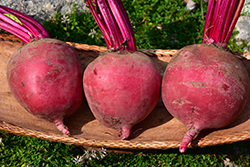Height: 10 inches Spacing: 4 inches
Sunlight:
Hardiness Zone: (annual) Other Names: Chioggia Beet Group/Class: Heirloom Description: A well loved Italian heirloom that produces 3" wide beets with white and red inner circles; very sweet and flavorful, great for pickling, baking or frying into chips; beet greens can be used as a spinach substitute and tastes delicious raw or sauteed Edible Qualities Candy Cane Beet is an annual vegetable plant that is commonly grown for its edible qualities. The entire above-ground parts of the plant are edible, and are usually harvested from mid summer to early fall. The edible parts have a sweet taste and a crisp texture. The plant is most often used in the following ways:
Planting & Growing Candy Cane Beet will grow to be about 10 inches tall at maturity, with a spread of 12 inches. When planted in rows, individual plants should be spaced approximately 4 inches apart. This fast-growing vegetable plant is an annual, which means that it will grow for one season in your garden and then die after producing a crop. Because of its relatively short time to maturity, it lends itself to a series of successive plantings each staggered by a week or two; this will prolong the effective harvest period. This plant is typically grown in a designated vegetable garden. It should only be grown in full sunlight. It does best in average to evenly moist conditions, but will not tolerate standing water. It is not particular as to soil pH, but grows best in rich soils. It is somewhat tolerant of urban pollution. This is a selected variety of a species not originally from North America, and it is considered by many to be an heirloom variety. Candy Cane Beet is a good choice for the vegetable garden, but it is also well-suited for use in outdoor pots and containers. It is often used as a 'filler' in the 'spiller-thriller-filler' container combination, providing the canvas against which the thriller plants stand out. Note that when growing plants in outdoor containers and baskets, they may require more frequent waterings than they would in the yard or garden. Characteristics
Applications
Features & Attributes
|
